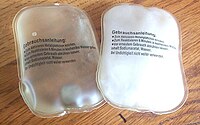
Photo from wikipedia
For some products, degradation mechanisms change during testing, and therefore, their degradation patterns vary at different points in time; these points are called change-points. Owing to the limitation of measurement… Click to show full abstract
For some products, degradation mechanisms change during testing, and therefore, their degradation patterns vary at different points in time; these points are called change-points. Owing to the limitation of measurement costs, time intervals for degradation measurements are usually very long, and thus, the value of change-points cannot be determined. Conventionally, a certain degradation measurement is selected as the change-point in a two-phase degradation process. According to the tendency of the two-phase degradation process, the change-point is probably located in the interval between two neighboring degradation measurements, and it is a fuzzy variable. The imprecision of the change-point may lead to the incorrect product’s reliability evaluation results. In this paper, based on the fuzzy theory, a two-phase degradation model with a fuzzy change-point and a statistical analysis method are proposed. First, a two-phase Wiener degradation model is developed according to the membership function of the change-point. Second, the reliability evaluation is carried out using maximum likelihood estimation and a fuzzy simulation approach. Finally, the proposed methodology is verified via a case study. The results of the study show that the proposed methodology can achieve more believable reliability evaluation results compared with those of the conventional approach.
Journal Title: Journal of Shanghai Jiaotong University (science)
Year Published: 2021
Link to full text (if available)
Share on Social Media: Sign Up to like & get
recommendations!